Glacier travel is an exhilarating experience that combines breathtaking natural beauty with thrilling exploration. Whether you are an adventure enthusiast seeking a unique adrenaline rush or a nature lover yearning to witness the awe-inspiring wonders of ice and snow, glacier travel offers an unforgettable journey.

In this comprehensive guide, we will delve into the world of glacier travel, providing you with insights, tips, and essential information to make the most of your expedition.
Understanding Glaciers: Nature’s Frozen Marvels
What Are Glaciers?
Glaciers are massive bodies of ice formed by the accumulation and compression of snow over time. These majestic frozen wonders shape the land and create breathtaking landscapes. They are found in regions with ample snowfall and cold temperatures, such as high-altitude mountains and polar areas.

Once you reach and exceed 4,000m (13,100 feet) in elevation, you are likely to come across a glacier, even if you are in the tropics. At higher latitudes, glaciers are found at lower elevations. Glaciers can be categorized into two main types: dry glaciers and wet glaciers.
Dry glaciers are characterized by the absence of snow on their surface, allowing travelers to traverse directly on the ice. These glaciers are typically encountered during the late spring or summer when the snow has melted away. One significant advantage of dry glaciers is that they offer better visibility of crevasses, making them comparatively safer to cross.
In contrast, wet glaciers are covered with a layer of snow. They are primarily categorized as wet during the winter and early spring when snowfall is more frequent. The presence of snow on the glacier surface makes it harder to spot crevasses and variations in the ice texture, adding an extra level of complexity and potential risk to glacier travel.

When traveling on wet glaciers, it becomes essential to employ additional caution and safety measures. Travelers should be well-equipped with the necessary gear, including avalanche safety equipment, to mitigate potential hazards. It is also advisable to have proper training and experience in glacier travel techniques, such as route finding and crevasse rescue.
Key Glacier Features
Understanding the key features of glaciers will help you navigate and appreciate their beauty:
Snow Bridges
A snow bridge refers to the layer of snow that covers a crevasse, creating a temporary bridge. Snow bridges can vary in strength and stability. Some may be thick, well-frozen, and capable of supporting a person’s weight, while others may be thin, unfrozen, and fragile, posing a risk of collapse. To mitigate the danger of falling into a crevasse, it is crucial to travel roped up as part of a team.

Crevasses
Crevasses are deep cracks or fissures that form in glaciers due to the movement and stress within the ice. While crevasses can appear almost anywhere and in any direction, there are specific areas on glaciers where they are more commonly found. They often form in the following places:
- Areas where two crevasses intersect.
- The lower end of a glacier.
- Steep sections of a glacier.
Navigating around crevasses requires caution and skill. It is crucial to be able to identify potential crevasse locations and take appropriate measures to avoid them. Being roped up as a team and having experienced guides or mountaineers with knowledge of crevasse rescue techniques is highly recommended.
Seracs
Seracs are large blocks or columns of glacial ice that often form in specific conditions. They can be found where crevasses intersect, at the lower portions of glaciers, or in areas where the glacier’s slope increases dramatically.
Seracs pose a significant danger as they can collapse without warning, resulting in the release of massive ice blocks. Travelers passing beneath seracs are at risk of being struck by falling ice. Minimizing exposure time by altering the route or moving efficiently without unnecessary stops is crucial when traveling in areas with seracs.
Always prioritize safety and take precautions to avoid potential hazards.
Whiteouts
Whiteouts occur when fog or clouds descend on a glacier, creating a visually disorienting environment where snow, sky, and terrain blend into a single white blur. Traveling in complicated glaciated terrain during whiteout conditions can be extremely dangerous, as it becomes challenging to make accurate route choices.
Even if the weather is clear during the approach, it is advisable to track your route using GPS or other navigational tools. This way, if clouds roll in, you can follow your path back and minimize the risk of getting lost.
Rockfall
Glaciers bordered by steep mountains or during rock climbing on adjacent rock faces can expose travelers to the risk of rockfall. The hazard of rockfall is reduced during the night when lower temperatures freeze rocks in place.
However, the most dangerous times for rockfall occur in late morning, when direct sunlight melts the bond between ice and rock, and in the evenings when freeze-thaw cycles occur due to meltwater.
Avalanches
When approaching alpine climbing objectives, it is common to encounter snow slopes that are susceptible to avalanches. Avalanche hazards are complex and require specific knowledge and expertise to navigate safely.
It is recommended to study resources like “Staying Alive in Avalanche Terrain” by Bruce Tremper to gain a comprehensive understanding of avalanche safety and mitigation techniques. Assessing current avalanche conditions and using proper equipment, such as transceivers, probes, and shovels, are crucial for safe travel in avalanche-prone areas.

Safety Tips and Tricks for Glacier Travel
Glacier travel demands thorough preparation and adherence to safety guidelines. Here are key considerations for ensuring safety:
- Acquire comprehensive training and knowledge in glacier travel techniques, crevasse rescue, and avalanche safety.
- Always travel with experienced guides or knowledgeable companions who are familiar with the terrain.
- Equip yourself with appropriate gear, including harnesses, helmets, crampons, ice axes, and avalanche safety equipment.
- Stay updated on current glacier conditions, weather forecasts, and avalanche bulletins.
- Conduct thorough route planning, assessing potential hazards, and adjusting plans accordingly.
- Communicate your travel plans with reliable contacts who can raise the alarm if necessary.
- Regularly refresh your skills and stay informed about the latest safety practices.
By prioritizing safety, maintaining a cautious mindset, and respecting the power of nature, glacier travel can be a rewarding and awe-inspiring experience. Embrace the adventure while taking necessary precautions to ensure a memorable and safe journey amidst the stunning glacial landscapes.
Exploring Glaciers: Potanin Glacier of Mongolia
One remarkable glacier destination is the Khüiten Mountain in Mongolia. Rising to an elevation of 4,374 meters (14,201 feet), Khüiten Mountain is the highest peak in Mongolia and is located in the remote Altai Tavan Bogd National Park. The region offers breathtaking glaciers, including the Potanin Glacier, and presents an awe-inspiring landscape for mountaineers and adventure enthusiasts.
When venturing on a glacier expedition to Khüiten Mountain, it is imperative to prioritize thorough preparation, possessing essential skills and knowledge, and being accompanied by experienced guides or local mountaineering experts. At Discoveraltai, we take pride in providing a diverse range of exceptional experiences tailored to meet all your glacier travel aspirations.





















